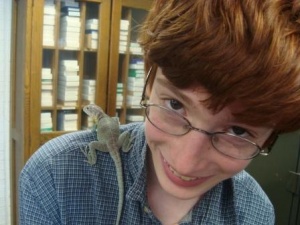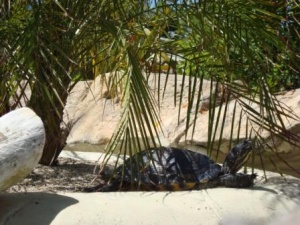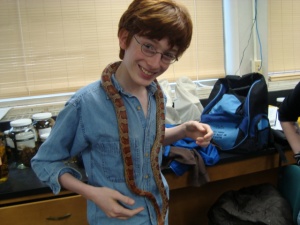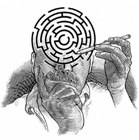Difference between revisions of "Colin Carlson"
ColinCarlson (Talk | contribs) m (→''Pelargonium'' Plasticity) |
ColinCarlson (Talk | contribs) m |
||
| Line 19: | Line 19: | ||
<tt>''"I know the human being and fish can coexist peacefully." - George W. Bush''</tt> | <tt>''"I know the human being and fish can coexist peacefully." - George W. Bush''</tt> | ||
| − | [[Image:DSC00821.JPG|thumb|300px|left|A painted turtle coexistin' peacefully in San Diego.]] | + | [[Image:DSC00821.JPG|thumb|300px|left|A painted turtle coexistin' peacefully with a palm in San Diego.]] |
One of the major problems that faces conservation and environmental advocacy is that advocates don't get the environment, and environmental biologists aren't skilled advocates. This gap between activism and science is one that I have found to be a major obstacle in my environmental work as director of the [http://webpages.charter.net/cool_coventry_club/home.htm Cool Coventry Club] and steering comittee member of the Connecticut Youth Activist Network, and is one that has shaped my career goals profoundly. More about me: I'm part of the EcoHouse living community on campus (and will continue to be next year), a member of environmental organizations such as EcoHusky, and recently found out I was awarded a '''2010 Udall Scholarship''' for my environmental work!! This scholarship will be invaluable to me, as it involves a week-long training conference in Arizona this summer, which will give me more tools to spread my environmental message. After UConn, I plan to go to graduate school to receive my Ph.D., but I won't stop there - law school seems to be a reasonable next step. After all, science and policy should go hand in hand - so even though I might end up in either field, both degrees will be of use to me. | One of the major problems that faces conservation and environmental advocacy is that advocates don't get the environment, and environmental biologists aren't skilled advocates. This gap between activism and science is one that I have found to be a major obstacle in my environmental work as director of the [http://webpages.charter.net/cool_coventry_club/home.htm Cool Coventry Club] and steering comittee member of the Connecticut Youth Activist Network, and is one that has shaped my career goals profoundly. More about me: I'm part of the EcoHouse living community on campus (and will continue to be next year), a member of environmental organizations such as EcoHusky, and recently found out I was awarded a '''2010 Udall Scholarship''' for my environmental work!! This scholarship will be invaluable to me, as it involves a week-long training conference in Arizona this summer, which will give me more tools to spread my environmental message. After UConn, I plan to go to graduate school to receive my Ph.D., but I won't stop there - law school seems to be a reasonable next step. After all, science and policy should go hand in hand - so even though I might end up in either field, both degrees will be of use to me. | ||
Revision as of 16:51, 9 April 2010
I am a fourth semester honors double degree student in EEB (B.S.) and IMJR - Environmental Studies (B.A.), currently studying plasticity in the genus Pelargonium. I've also just been named a 2010 Udall Scholar for my environmental work on and off campus.
Contents
Research Interests
Phenotypic plasticity; environmental law and conservation biology; morphological constraints on performance; society-environment interactions.
Snapping Turtle Research
This project analyzed the behavior of three Snapping Turtles (Chelydra serpentina) along the Connecticut river. The footage, collected over the summer, was from three turtles: Jawless and Lafayette from Wethersfield Cove, and Snippy from Shenipsit Lake. (see the snapping turtle research team page for the full story on the turtles). Also, for more information on Crittercam itself, visit National Geographic's Crittercam Homepage. This analysis encompasses the breath, dive, pausing, walking, and other aspects of locomotion of the three turtles. If you would like to read more about the actual data analysis going into the project, check out Snapping Turtle Research: Analyses and Conclusions.
My research on this project was divided into two main stages. First came an analysis of the duration and frequency of breathing and diving behaviors, an analysis that revealed a strong positive relationship between breath and dive duration. Second, I analyzed behavioral patterns in the turtles through an analysis of locomotion divided into five sub-categories, and found strong differences between their average limb frequency cycles.
Pelargonium Plasticity
After working for a year on the Snapping Turtle Research project, and helping it get to that glorious moment of publication, I’ve finally turned to my thesis research, on the spatial gradients and phylogenetic distribution of phenotypic plasticity in South African Pelargonium L’Her (Geraniaceae). I am currently planning to travel to South Africa this summer with the NSF IRES 2010 group to measure leaf shape variation in a natural context; upon my return I will begin a series of greenhouse experiments primarily examining light plasticity, in particular in the context of population differences or interspecific differences. In effect, I'll be trying to answer two questions: how much leaf variation is actually genetic but mistaken for plasticity, and (as well as what factors trigger plasticity) how plasticity has evolved within the genus.
Conservation Philosophy and Career Aspirations
"I know the human being and fish can coexist peacefully." - George W. Bush
One of the major problems that faces conservation and environmental advocacy is that advocates don't get the environment, and environmental biologists aren't skilled advocates. This gap between activism and science is one that I have found to be a major obstacle in my environmental work as director of the Cool Coventry Club and steering comittee member of the Connecticut Youth Activist Network, and is one that has shaped my career goals profoundly. More about me: I'm part of the EcoHouse living community on campus (and will continue to be next year), a member of environmental organizations such as EcoHusky, and recently found out I was awarded a 2010 Udall Scholarship for my environmental work!! This scholarship will be invaluable to me, as it involves a week-long training conference in Arizona this summer, which will give me more tools to spread my environmental message. After UConn, I plan to go to graduate school to receive my Ph.D., but I won't stop there - law school seems to be a reasonable next step. After all, science and policy should go hand in hand - so even though I might end up in either field, both degrees will be of use to me.
Publications
Landberg, T., Carlson, C. J., Abernathy, K., Luginbuhl, C., Gemme, P. and Mergins, C. (2010) Natural History Notes: CHELYDRA SERPENTINA SERPENTINA L. (Eastern Snapping Turtle). SURVIVAL AFTER INJURY. Herpetological Review 41(1):70-71.



